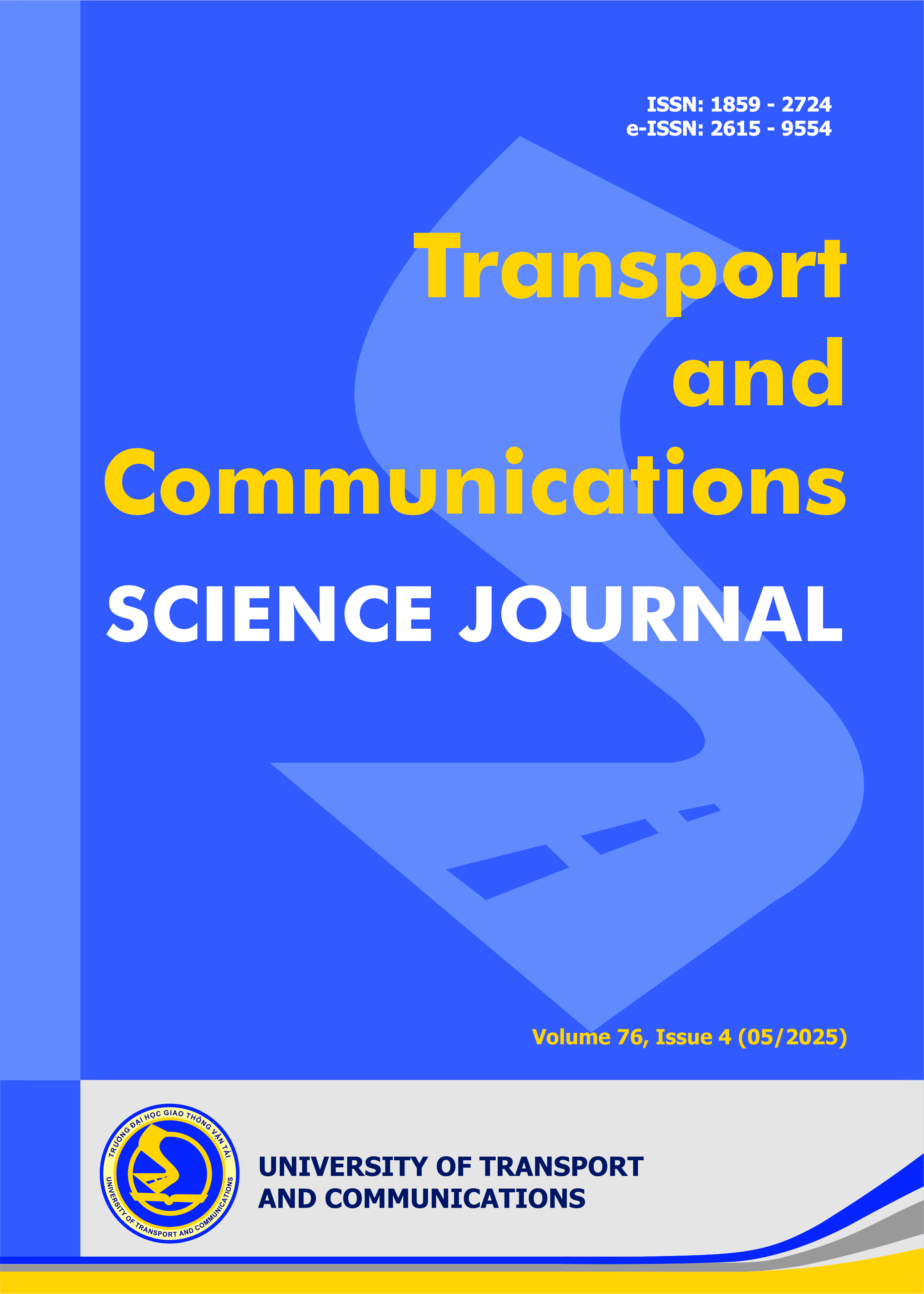Online determination of reference currents for wide-speed range operation of IPMSM in electric vehicles using the Newton-Raphson method
Email:
lichnt@utc.edu.vn
Tóm tắt
The Interior Permanent Magnet Synchronous Motor (IPMSM) has been widely employed as a preferred choice for electric vehicle (EV) because of its advantageous characteristics such as high efficiency, high-power density, and a robust operation. This paper focuses on the control of an IPMSM for EV applications, with emphasis on smooth transitions over a wide speed range, including both normal and high-speed operating regions. A comprehensive review of state-of-the-art IPMSM control methods is provided, followed by fundamental machine principles. Over-modulation techniques are then presented to effectively manage the maximum voltage of the DC-link source, a critical aspect for EV powertrains. In order to control the machine over a wide-speed range, a flux-weakening method has to be adopted by combining the conventional space vector modulation (SVM) in the normal speed range and the voltage angle control in the high-speed regions. A key innovation of this study is the use of the Newton-Raphson method to determine the optimum operating point of the IPMSM, minimizing the stator current for a given torque demand. This optimization not only maximizes the torque capability over the entire speed range, but also enhances the dynamic performance of the system, which is essential for EV applications requiring rapid and precise response. The proposed control strategy combines SVM with overmodulation techniques, enabling seamless transitions between low- and high-speed regions. Simulation results are used to validate the effectiveness of the proposed control strategy, demonstrating stable and robust performance under varying speed and load torque conditions, highlighting its potential for applications in wide-speed-range IPMSM-based EV systemsTài liệu tham khảo
[1]. J. Fang, C. Heising, V. Staudt, A. Steimel, Permanent-magnet synchronous machine model for urban transport applications, Proc. 12th Int. Conf. Optim. Electr. Electron. Equip., (2010) 358-363. https://doi.org/10.1109/OPTIM.2010.5510539
[2]. P. B. Reddy, A. M. El-Refaie, K. K. Huh, J. K. Tangudu, T. M. Jahns, Comparison of interior and surface PM machines equipped with fractional-slot concentrated windings for hybrid traction applications, IEEE Trans. Energy Convers., 27 (2012) 593-602. https://doi.org/10.1109/TEC.2012.2195316
[3]. W. Wang, M. Cheng, B. Zhang, Y. Zhu, S. Ding, A fault-tolerant permanent-magnet traction module for subway applications, IEEE Trans. Power Electron., 29 (2014) 1646-1658. https://doi.org/10.1109/TPEL.2013.2266377
[4]. K. C. Kim, A novel calculation method on the current information of vector inverter for interior permanent magnet synchronous motor for electric vehicle, IEEE Trans. Mag., 50 (2014) 829-832. https://doi.org/10.1109/TMAG.2013.2279555
[5]. M. S. Lim, S.-H. Chai, J.-P. Hong, Design of saliency-based sensorless-controlled IPMSM with concentrated winding for EV traction, IEEE Trans. Magn., 52 (2016). https://doi.org/10.1109/TMAG.2015.2474123
[6]. H. C. Jung, G.-J. Park, D.-J. Kim, S.-Y. Jung, Optimal design and validation of IPMSM for maximum efficiency distribution compatible to energy consumption areas of HD-EV, IEEE Trans. Magn., 53 (2017). https://doi.org/10.1109/CEFC.2016.7816180
[7]. S. C. Carpiuc, Rotor temperature detection in permanent magnet synchronous machine-based automotive electric traction drives, IEEE Trans. Power Electron., 32 (2017) 2090-2097. https://doi.org/10.1109/TPEL.2016.2567238
[8]. J. M. Mun, G.-J. Park, S. Seo, D.-W. Kim, Y.-J. Kim, S.-Y. Jung, Design characteristics of IPMSM with wide constant power speed range for EV traction, IEEE Trans. Magn., 53 (2017). https://doi.org/10.1109/TMAG.2017.2664859
[9]. G. Pellegrino, A. Vagati, P. Guglielmi, B. Boazzo, Performance comparison between surface-mounted and interior PM motor drives for electric vehicle application, IEEE Trans. Ind. Electron., 59 (2012) 803-811. https://doi.org/10.1109/TIE.2011.2151825
[10]. A. Vagati, G. Pellegrino and P. Guglielmi, Comparison between SPM and IPM motor drives for EV application, Proc. XIX Int. Conf. ICEM, (2010) 1-6. https://doi.org/10.1109/ICELMACH.2010.5607911
[11]. J. Holtz, W. Lotzkat, A. M. Khambadkone, On continuous control of PWM inverters in the overmodulation range including the six-step mode, IEEE Trans. Power Electron., 8 (1993) 546–553. https://doi.org/10.1109/63.261026
[12]. Dong-Choon Lee, G-Myoung Lee, A novel overmodulation technique for space-vector PWM inverters, IEEE Trans. Power Electron., 13 (1998) 1144–1151. https://doi.org/10.1109/63.728341
[13]. T. M. Jahns, Flux-Weakening Regime Operation of an Interior Permanent-Magnet Synchronous Motor Drive, IEEE Trans. Ind. Appl., 23 (1987) 681–689. https://doi.org/10.1109/TIA.1987.4504966
[14]. T. Miyajima, H. Fujimoto, M. Fujitsuna, A Precise Model-Based Design of Voltage Phase Controller for IPMSM, IEEE Trans. Power Electron., 28 (2013) 5655–5664. https://doi.org/10.1109/TPEL.2013.2259262
[15]. S. Bolognani, S. Calligaro, R. Petrella, F. Pogni, Flux-weakening in IPM motor drives: Comparison of state-of-art algorithms and a novel proposal for controller design, Proceedings of the 2011 14th European Conference on Power Electronics and Applications, (2011) 1-11.
[16]. L. Tian-Hua, Maximum efficiency control and predictive-speed controller design for interior permanent magnet synchronous motor drive systems, Frontiers in Electronics., 3(2022) https://doi.org/10.3389/felec.2022.904976
[17]. L. Qinghua, Analysis, design and control of permanent magnet synchronous motors for wide-speed operation, PhD Thesis, 2005. Accessed: 2021. [Online]. Available: https://scholarbank.nus.edu.sg/handle/10635/15011
[18]. T. Plazenet, T. Boileau, C. Caironi, B. Nahid-Mobarakeh, A Comprehensive Study on Shaft Voltages and Bearing Currents in Rotating Machines, IEEE Trans. Ind. Appl., 54 (2018) 3749 - 3759. https://doi.org/10.1109/TIA.2018.2818663
[19]. Y. Inoue, K. Yamada, S. Morimoto, M. Sanada, Effectiveness of Voltage Error Compensation and Parameter Identification for Model-Based Sensorless Control of IPMSM, IEEE Trans. Ind. Appl., 45 (2009) 213–221. https://doi.org/10.1109/TIA.2008.2009617
[20]. T. Söderström and L. Ljung, Theory and Practice of Recursive Identification. Cambridge, MA, USA: MIT Press, 1983.
[2]. P. B. Reddy, A. M. El-Refaie, K. K. Huh, J. K. Tangudu, T. M. Jahns, Comparison of interior and surface PM machines equipped with fractional-slot concentrated windings for hybrid traction applications, IEEE Trans. Energy Convers., 27 (2012) 593-602. https://doi.org/10.1109/TEC.2012.2195316
[3]. W. Wang, M. Cheng, B. Zhang, Y. Zhu, S. Ding, A fault-tolerant permanent-magnet traction module for subway applications, IEEE Trans. Power Electron., 29 (2014) 1646-1658. https://doi.org/10.1109/TPEL.2013.2266377
[4]. K. C. Kim, A novel calculation method on the current information of vector inverter for interior permanent magnet synchronous motor for electric vehicle, IEEE Trans. Mag., 50 (2014) 829-832. https://doi.org/10.1109/TMAG.2013.2279555
[5]. M. S. Lim, S.-H. Chai, J.-P. Hong, Design of saliency-based sensorless-controlled IPMSM with concentrated winding for EV traction, IEEE Trans. Magn., 52 (2016). https://doi.org/10.1109/TMAG.2015.2474123
[6]. H. C. Jung, G.-J. Park, D.-J. Kim, S.-Y. Jung, Optimal design and validation of IPMSM for maximum efficiency distribution compatible to energy consumption areas of HD-EV, IEEE Trans. Magn., 53 (2017). https://doi.org/10.1109/CEFC.2016.7816180
[7]. S. C. Carpiuc, Rotor temperature detection in permanent magnet synchronous machine-based automotive electric traction drives, IEEE Trans. Power Electron., 32 (2017) 2090-2097. https://doi.org/10.1109/TPEL.2016.2567238
[8]. J. M. Mun, G.-J. Park, S. Seo, D.-W. Kim, Y.-J. Kim, S.-Y. Jung, Design characteristics of IPMSM with wide constant power speed range for EV traction, IEEE Trans. Magn., 53 (2017). https://doi.org/10.1109/TMAG.2017.2664859
[9]. G. Pellegrino, A. Vagati, P. Guglielmi, B. Boazzo, Performance comparison between surface-mounted and interior PM motor drives for electric vehicle application, IEEE Trans. Ind. Electron., 59 (2012) 803-811. https://doi.org/10.1109/TIE.2011.2151825
[10]. A. Vagati, G. Pellegrino and P. Guglielmi, Comparison between SPM and IPM motor drives for EV application, Proc. XIX Int. Conf. ICEM, (2010) 1-6. https://doi.org/10.1109/ICELMACH.2010.5607911
[11]. J. Holtz, W. Lotzkat, A. M. Khambadkone, On continuous control of PWM inverters in the overmodulation range including the six-step mode, IEEE Trans. Power Electron., 8 (1993) 546–553. https://doi.org/10.1109/63.261026
[12]. Dong-Choon Lee, G-Myoung Lee, A novel overmodulation technique for space-vector PWM inverters, IEEE Trans. Power Electron., 13 (1998) 1144–1151. https://doi.org/10.1109/63.728341
[13]. T. M. Jahns, Flux-Weakening Regime Operation of an Interior Permanent-Magnet Synchronous Motor Drive, IEEE Trans. Ind. Appl., 23 (1987) 681–689. https://doi.org/10.1109/TIA.1987.4504966
[14]. T. Miyajima, H. Fujimoto, M. Fujitsuna, A Precise Model-Based Design of Voltage Phase Controller for IPMSM, IEEE Trans. Power Electron., 28 (2013) 5655–5664. https://doi.org/10.1109/TPEL.2013.2259262
[15]. S. Bolognani, S. Calligaro, R. Petrella, F. Pogni, Flux-weakening in IPM motor drives: Comparison of state-of-art algorithms and a novel proposal for controller design, Proceedings of the 2011 14th European Conference on Power Electronics and Applications, (2011) 1-11.
[16]. L. Tian-Hua, Maximum efficiency control and predictive-speed controller design for interior permanent magnet synchronous motor drive systems, Frontiers in Electronics., 3(2022) https://doi.org/10.3389/felec.2022.904976
[17]. L. Qinghua, Analysis, design and control of permanent magnet synchronous motors for wide-speed operation, PhD Thesis, 2005. Accessed: 2021. [Online]. Available: https://scholarbank.nus.edu.sg/handle/10635/15011
[18]. T. Plazenet, T. Boileau, C. Caironi, B. Nahid-Mobarakeh, A Comprehensive Study on Shaft Voltages and Bearing Currents in Rotating Machines, IEEE Trans. Ind. Appl., 54 (2018) 3749 - 3759. https://doi.org/10.1109/TIA.2018.2818663
[19]. Y. Inoue, K. Yamada, S. Morimoto, M. Sanada, Effectiveness of Voltage Error Compensation and Parameter Identification for Model-Based Sensorless Control of IPMSM, IEEE Trans. Ind. Appl., 45 (2009) 213–221. https://doi.org/10.1109/TIA.2008.2009617
[20]. T. Söderström and L. Ljung, Theory and Practice of Recursive Identification. Cambridge, MA, USA: MIT Press, 1983.
Tải xuống
Chưa có dữ liệu thống kê

Nhận bài
19/11/2024
Nhận bài sửa
07/03/2025
Chấp nhận đăng
10/05/2025
Xuất bản
15/05/2025
Chuyên mục
Công trình khoa học
Kiểu trích dẫn
Thanh Lich, N., & Thanh Loan, P. (1747242000). Online determination of reference currents for wide-speed range operation of IPMSM in electric vehicles using the Newton-Raphson method. Tạp Chí Khoa Học Giao Thông Vận Tải, 76(4), 541-555. https://doi.org/10.47869/tcsj.76.4.8
Số lần xem tóm tắt
79
Số lần xem bài báo
44









